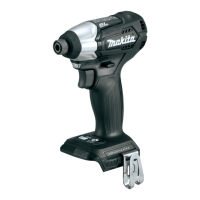
Do you have a question about the Makita XDT15 and is the answer not in the manual?
| Brand | Makita |
|---|---|
| Model | XDT15 |
| Category | Cordless impact driver |
| Language | English |
Follow all safety warnings to prevent electric shock, fire, and injury.
Stay alert, use PPE, prevent unintentional starting, and remove adjustment keys.
Use correct tools, maintain them, and follow battery charging/care guidelines.
Hold by insulated grip, ensure footing, avoid hot surfaces, and keep hands from moving parts.
Avoid shorting, store properly, do not incinerate, drop, or use damaged batteries. Follow disposal rules.
Charge before discharge, avoid overcharging, charge at optimal temperatures.
Switch off tool, hold firmly, align and slide cartridge until it locks securely.
Check remaining battery capacity using indicator lamps and a button.
Overload, overheat, and overdischarge protection automatically stops the tool for safety and longevity.
Control tool speed with the trigger; the electric brake provides quick stopping.
Pull trigger to turn on lamp; status can be set to ON or OFF for continuous use.
Use reversing switch lever to change rotation direction. Always stop tool before changing.
Adjust impact force in three steps (Hard, Soft, A mode) for suitable tightening applications.
Table showing maximum blows, purpose, and applications for each impact force grade.
Pull sleeve, insert/remove bit, release sleeve to secure. Ensure bit is firmly seated.
Insert hook into housing groove and secure with screw on either side for temporary hanging.
Torque depends on screw type, material, and fastening time.
Visual guide showing fastening torque vs. time for standard bolts.
Visual guide showing fastening torque vs. time for high tensile bolts.
Factors like battery, bit, bolt type, and holding affect torque. Perform test operations.
List of recommended accessories like bits, hook, and carrying cases for safe use.
Covers defects for one year, excludes normal wear, abuse, and alterations.
Warning about chemicals in dust and how to reduce exposure via ventilation and safety equipment.